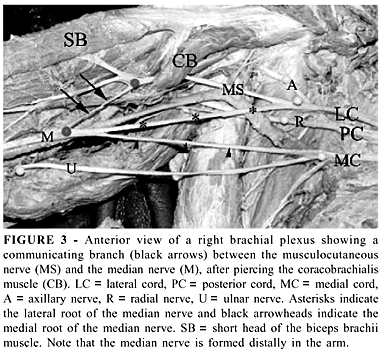PURPOSE: The brachial plexus has a complex anatomical structure since its origin in the neck throughout its course in the axillary region. It also has close relationship to important anatomic structures what makes it an easy target of a sort of variations and provides its clinical and surgical importance. The aims of the present study were to describe the brachial plexus anatomical variations in origin and respective branches, and to correlate these variations with sex, color of the subjects and side of the body. METHODS: Twenty-seven adult cadavers separated into sex and color had their brachial plexuses evaluated on the right and left sides. RESULTS: Our results are extensive and describe a large number of variations, including some that have not been reported in the literature. Our results showed that the phrenic nerve had a complete origin from the plexus in 20% of the cases. In this way, a lesion of the brachial plexus roots could result in diaphragm palsy. It is not usual that the long thoracic nerve pierces the scalenus medius muscle but it occurred in 63% of our cases. Another observation was that the posterior cord was formed by the posterior divisions of the superior and middle trunks in 9%. In these cases, the axillary and the radial nerves may not receive fibers from C7 and C8, as usually described. CONCLUSION: Finally, the plexuses studied did not show that sex, color or side of the body had much if any influence upon the presence of variations.
Anatomy; Axilla; Brachial plexus.; Anatomical variations; Peripheral nerves






